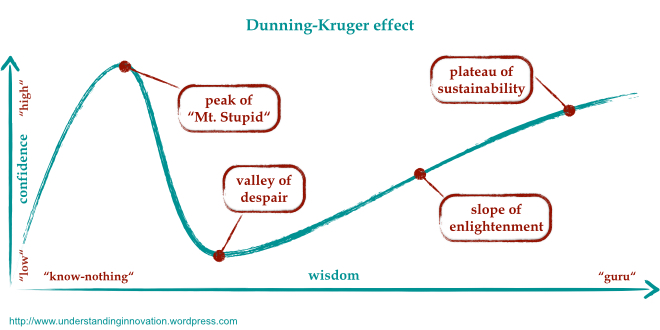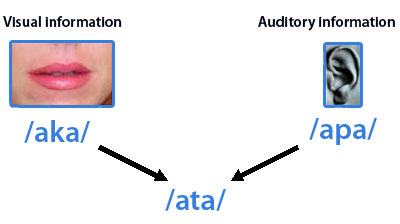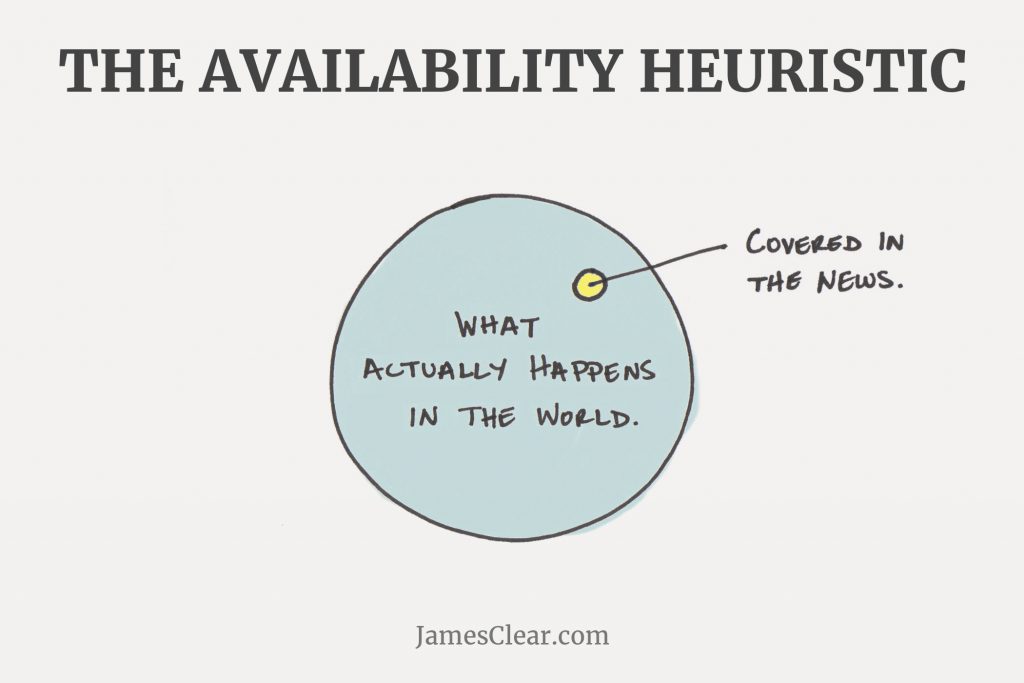Overview
The brain has proved to itself its spectacular rational thinking capabilities within the animal kingdom. In essence, the brain works by recognizing patterns which can be seen in the Baader-Meinhof phenomenon. It is very likely that you have already experienced this phenomenon. For example, imagine you have learned the new word “anthropomorphic”. Within the following week, you read it in a book, you hear it in a youtube video and maybe even during an English class. This coincidence seems astronomical to you, but in reality, your brain has just begun to pick up on this new “pattern”, which you have seen many times before, but just have not recognized. We are constantly bombarded with sensory information and patterns which we rely on our brain to autonomously interpret and understand. The brain has many tendencies during this process, which we can view as psychological phenomena.
Dunning-Kruger Effect

The Dunning-Kruger Effect discovered by David Dunning and Justin Kruger explains the tendency for people with a low ability in a task to overestimate their capabilities while people with high ability in a task tend to underestimate themselves as expressed by the graph on the left. Every person who begins to learn something new will inevitably go through the “Mt. Stupid” phase. Many students may feel extremely confident for a test, studying the night before, just to realize 5 minutes before the test that they virtually know nothing. That is the transition from “Mt. Stupid” to the “valley of despair”. This Dunning-Kruger effect can be seen in all sorts of fields among which IQ is prominent. People with low IQ tend to overestimate their intelligence while people with high IQ tend to underestimate their intelligence.
McGurk Effect
The McGurk effect is the effect by which visual information is integrated or overrides auditory information. As seen in the image on the left, although the receiver hears the word “apa”, if they see that the speaker’s mouth is in the form that pronounces “aka”, the visual and auditory information is integrated into “ata”. Another example is when the receiver hears the sound “baa” but sees the mouth pronounce “faa”. In this case, the visual information overrides the auditory information, and the receiver hears the sound “faa” although he hears “baa”. This effect does not need to be with visual-auditory information to be observed. In the following link is a toy that is supposed to say “Brainstorm” but can be also heard as “Green Needle” or a combination of both.

Zero-Risk Bias
The zero-risk bias is a bias in which people would prefer to completely eliminate a risk rather than a mitigation of a larger risk. A plane accident is much more unlikely to happen than a car accident, but if people are given the two choices of completely eliminating plane accidents or halving the car accidents, they would prefer the former.
Availability Heuristic Bias

This is the tendency for people to overrate available information. As an example, many people fear going to the ocean because they are afraid of being attacked by sharks. They might see a post on Instagram saying how a boy had his arm severed by a shark, or simply watched the movie “Jaws”. Shark attacks are quite rare and it is much more likely that a person dies from choking on a sausage. But, because people forget to rule out the possibility of other information, they tend to overrate the information that they have and think they know most or everything of that subject.
Loss Aversion Bias
The loss aversion bias is the tendency for the human mind to prefer avoiding loss instead of acquiring something. If a person flips a coin and receives 10$ for a head and loses $10 for a tail, the person would feel a slight boost in satisfaction for a head, but a greater loss in satisfaction for a tail. When a person is sorting out their room, they may be inclined to keep certain items, because they think they might use it sometime later when in reality they will never use it. This is a common example of the loss aversion bias that many people experience.
[1] Bastien-Toniazzo Mireille. 2009. “Audio-Visual Perception and Integration in Developmental Dyslexia: An Exploratory Study Using the McGurk Effect”. OpenEditionJournals. https://journals.openedition.org/cpl/4928?lang=fr. 07/16/20.
[2] Tiippana Kaisa. 2014. “What is the McGurk effect?”. frontiers. https://www.frontiersin.org/articles/10.3389/fpsyg.2014.00725/full. 07/16/20.
[3] Fickenscher Elizabeth. 2018. “10 Fascinating Psychological Phenomena”. TopTenz. https://www.toptenz.net/10-fascinating-psychological-phenomena.php. 07/16/20.
[4] Clear James. “5 Common Mental Errors That Sway You From Making Good Decisions”. James Clear. https://jamesclear.com/common-mental-errors. 07/16/20.
[5] Fehlhaber Kate. 2017. “Studies find high achievers underestimate their talents, while underachievers overestimate theirs”. Quartz. https://qz.com/992127/studies-find-high-achievers-underestimate-their-talents-while-underachievers-overestimate-theirs/. 07/16/20.
[6] Ehlert Ulf. 2015. “The Dunning-Kruger effect in Innovation”. UnderstandingInnovation. https://understandinginnovation.blog/2015/07/03/the-dunning-kruger-effect-in-innovation/. 07/16/20.
[7] Krockow Eva. 2020. “Is a Zero-Risk Bias Impairing Your Crisis Response?”. Psychology Today. https://www.psychologytoday.com/us/blog/stretching-theory/202003/is-zero-risk-bias-impairing-your-crisis-response. 07/16/20.
[8] 2016. “Rosy Retrospection: A Look at the Psychological Phenomenon”. Northeastern University. https://online.seu.edu/articles/rosy-retrospection-a-look-at-the-psychological-phenomenon/. 07/16/20.
